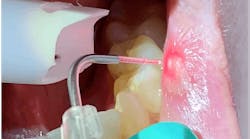Dental coding updates: Is your staff prepared for CDT 2018?
DO YOU BILL MEDICAL INSURANCE FOR MEDICALLY NECESSARY DENTAL PROCEDURES performed in your dental practice? If so, it’s important to understand the changes to the CDT codes for 2018. If you find yourself using some of the following new codes, it might be a sign that you should consider billing medical insurance for some specific procedures.
Updating your billing procedures to reflect the new codes
The new codes are now in effect, so it’s time to train your dental staff to use them. Remember, it’s not just the billing staff that needs to understand changes to codes. All clinical staff should receive training so that they can identify situations when the new codes might apply, understand when it’s necessary to gather more information on medical conditions related to a procedure, and document procedures fully so that they can be eligible for medical billing whenever possible.
For many patients, medical insurance may provide better coverage and lower out-of-pocket expenses than their dental coverage for the same procedure. By helping patients receive proper insurance coverage for necessary treatments, you ensure that they can adhere to a treatment plan and restore their health.
New CDT codes that may be eligible for medical cross-coding
Every insurance company has a strong understanding of the oral-systemic issues that are needed in order to help patients become healthy and stay healthy. Thousands of dental office surveys in New Jersey where patients were tested for diabetes found many to be positive, and they were sent to their medical doctors for collaborative treatment. Wow! Patients really do need their dentists!
Here is a selection of new diabetes codes and how they relate to medically necessary treatments.
• D0411—HbA1c in-office point of service testing
• 83036—Hemoglobin; glycosylated (A1C)
• 83037—Hemoglobin; glycosylated (A1C) by device cleared by FDA for home use
Implant codes
When you are replacing teeth for patients who cannot function with proper chewing and swallowing, they may have a medical necessity. Because many types of implants can now be billed medically, more patients will want to have the procedure. Does your office know how to bill medically for implants? Having the knowledge and diagnostic ability to perform these medical necessities is important for dental practices, as is knowing how to properly bill.
Many of the treatments have the same meaning when cross coding, so you must pay attention to choosing the proper cross code. For example:
• D6096—Remove broken implant retaining screw
• 20670—Removal of implant; superficial (e.g., buried wire, pin, or rod) (Separate procedure)
• D6118—Implant/abutment-supported interim fixed denture for edentulous arch, mandibular
• D6119—Implant/abutment-supported interim fixed denture for edentulous arch, maxillary
When billing these codes to medical, the office must write a letter of medical necessity, have a diagnostic code, and use 41899—unlisted procedures, dentoalveolar structures. This is used when a period of healing is necessary prior to fabrication and placement of the permanent prosthetic.
Below is an example of using an unlisted code:
More coding updates
D7296—Corticotomy, one to three teeth or tooth spaces, per quadrant
This procedure involves creating multiple cuts, perforations, or removal of cortical, alveolar, or basal bone of the jaw for the purpose of facilitating orthodontic repositioning of the dentition. The procedure includes flap entry and closure. Graft material and membrane, if used, should be reported separately.
D7297—Corticotomy, four or more teeth or tooth spaces, per quadrant
This procedure involves creating multiple cuts, perforations, or removal of cortical, alveolar, or basal bone of the jaw for the purpose of facilitating orthodontic repositioning of the dentition. This procedure includes flap entry and closure. graft material and membrane, if used, should be reported separately.
There are five medical codes used to translate these two dental codes, so make sure you are 100% sure where, when, how, and the size before you choose a cross code.
• D9995—Teledentistry, synchronous, real time encounter. Reported in addition to other procedures (e.g., diagnostic) delivered to the patient on the date of service.
• D9996—Teledentistry, asynchronous; information stored and forwarded to dentist for subsequent review. Reported in addition to other procedures (e.g., diagnostic) delivered to the patient on the date of service.
• 99444—Online evaluation and management service provided by a physician or other qualified health-care professional who may report an evaluation and management provided to an established patient or new patient.
Deleted codes
No longer use the following codes since they have been deleted, unless the treatment was completed in 2017 and you are just now sending the billing.
• D5510—Repair broken complete denture base
• D5610—Repair resin denture base
• D5620—Repair cast framework
Never give up
My hope is that you make some mistakes this year. If you’re making mistakes, then you’re trying new things, learning, and pushing yourself. You’ll be doing things you’ve never done before, and more importantly, you’ll be doing something—learning medical coding, which can only benefit your practice.
If you and your staff need more training in the new codes or help understanding how these new CDT codes relate to ICD-10 codes, the consultants atdentalmedicalbilling.comcan help you navigate. While coding changes can be confusing, in the long run these 2018 CDT additions and revisions will help you serve your patients better while receiving fair payment for your services.
For the most current practice management headlines, click here.
For the most current dental headlines, click here.
This document was developed from final actions of the Code Maintenance Committee (CMC). Use of the codes is allowed only if you have an existing CDT Licensing Agreement via the ADA, or are a working dental practice. Links2Success advises each office to purchase an updated 2018 coding book directly from the ADA at ebusiness.ada.org/ProductCatalog/productcategory.








